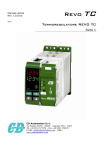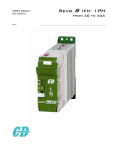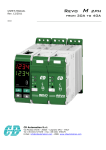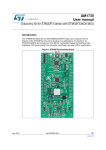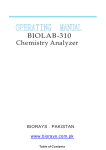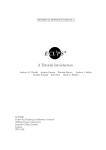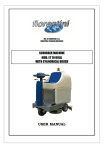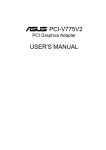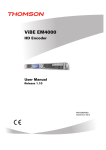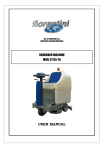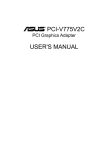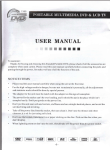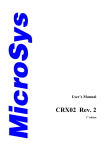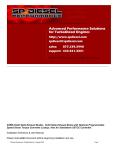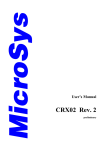Download manual - TMC Instruments
Transcript
USER’S MANUAL Rev. 12/2010 00005 Revo TC Temperature Controller Part 1 CD Automation srl pag. 2 di 121 CD Automation srl 1 Important warnings for safety ________________________________________ 8 2 Note ____________________________________________________________ 9 3 Identification and Order Code _______________________________________ 10 3.1 Identification of the unit ______________________________________________ 10 3.2 Order Code ________________________________________________________ 11 4 Technical Specifications ____________________________________________ 12 4.1 Environmental installation conditions ____________________________________ 12 4.2 Derating Curve _____________________________________________________ 12 5 Installation ______________________________________________________ 12 5.1 Dimensions and Weight ______________________________________________ 13 5.2 Fixing holes ________________________________________________________ 13 6 Wiring instructions ________________________________________________ 14 6.1 Out Terminal (Terminal block M1) ______________________________________ 14 6.2 Supply Terminal (Terminal block M2) ____________________________________ 14 6.3 Communication Terminal RS485 (Terminal block M3) _______________________ 14 6.4 Input Terminal (Terminal block M4) _____________________________________ 14 6.5 Connection Diagram _________________________________________________ 15 6.6 Access to Ln – Tn terminal Screw _______________________________________ 17 7 TU Module Basic __________________________________________________ 18 8 Control Panel ____________________________________________________ 19 9 Display _________________________________________________________ 21 9.1 Indicators _________________________________________________________ 22 9.2 Possible outputs REVO TCM (Temperature Controller only) ___________________ 22 9.3 Possible outputs REVO TC (SSR + Temperature Controller) __________________ 22 10 Operative Mode__________________________________________________ 23 11 Functions ______________________________________________________ 24 11.1 Special Functions __________________________________________________ 24 11.2 Manual Mode______________________________________________________ 25 11.3 Showing break-down alarm __________________________________________ 25 11.4 Showing leakage alarm _____________________________________________ 26 11.5 Showing loop-break alarm ___________________________________________ 26 12 Function “Soft start”______________________________________________ 26 13 Detection of malfunctions__________________________________________ 27 14 Programming Procedure___________________________________________ 28 14.1 Programming procedure Diagram______________________________________ 28 14.2 SET POINT Group ( SP )_____________________________________________ 29 14.3 ALARM Group ( AL ) ________________________________________________ 31 14.3.1 Alarm Function _________________________________________________________________ 33 14.3.2 Alarm Hysteresis _______________________________________________________________ 36 pag. 3 di 121 CD Automation srl 14.3.3 Alarm Out _____________________________________________________________________ 36 14.3.4 Action of alarm output. ___________________________________________________________ 37 14.3.5 Resetting of an Alarm ____________________________________________________________ 37 14.3.6 Alarm mask ___________________________________________________________________ 38 14.4 Control Group ( Cntr ) _____________________________________________ 39 14.5 OUT Group( Out ) _________________________________________________ 42 14.6 Group EHT (Functions setted also from input1 and input2)__________________ 44 14.7 Group DEF (default of run time Loading)________________________________ 46 14.8 Group PAL1 (Pallet 1 control parameters)_______________________________ 46 14.9 Group PAL2 (Pallet 2 control parameters)_______________________________ 48 14.10 Group PAL3 (Pallet 3 control parameters)______________________________ 48 15 SELF-TUNING Algorithms __________________________________________ 51 15.1 PreTune__________________________________________________________ 51 15.2 SelfTune _________________________________________________________ 52 16 Serial RS485 and USB communication interface_________________________ 53 17 Configuration Mode ______________________________________________ 54 17.1 Description _______________________________________________________ 54 17.2 Configuration procedure diagram ______________________________________ 55 17.3 Group INPUT (inP ) ________________________________________________ 57 17.4 Group I/O ( io ) ___________________________________________________ 59 17.4.1 Out 1 ________________________________________________________________________ 59 17.4.2 OUT 2 ________________________________________________________________________ 60 17.4.3 OUT 3 or Di 1 __________________________________________________________________ 61 17.4.4 Out 4 ________________________________________________________________________ 63 17.4.5 General_______________________________________________________________________ 64 17.5 ALARM Group( AL )_________________________________________________ 65 17.5.1 Alarm 1_______________________________________________________________________ 65 17.5.2 Alarm 2_______________________________________________________________________ 66 17.5.3 Alarm 3_______________________________________________________________________ 67 17.6 Heating Break-Down Group ( Hbdu ) __________________________________ 68 17.7 Loop break Group( LbAL ) ___________________________________________ 68 17.8 SELFTUNE Group( tunE )____________________________________________ 69 17.9 SOFT START Group ( SoFt )__________________________________________ 70 17.10 Gruppo PARAMETRI VARI ( niSC ) ___________________________________ 70 17.11 RS485 Group ( r485 )_____________________________________________ 73 17.12 Default Configuratiov Group ( deF )__________________________________ 74 17.13 Notes___________________________________________________________ 75 18 Serial communications ____________________________________________ 76 pag. 4 di 121 CD Automation srl 18.1 introduction to Modbus Protocol _______________________________________ 76 18.2 TABLE 0 _________________________________________________________ 78 18.3 WORDS ADDRESS__________________________________________________ 78 18.4 BITS ____________________________________________________________ 87 18.5 TABLE 1 (WEST 6600) ______________________________________________ 88 18.6 Status Table (Word 7) ______________________________________________ 89 19 Default Parameter Loading_________________________________________ 91 19.1 User procedure ____________________________________________________ 91 19.2 Loading Default operative parameter ___________________________________ 91 19.3 Default configuration parameter Loading ________________________________ 92 19.3.1 European table _________________________________________________________________ 93 19.3.2 Americana table ________________________________________________________________ 96 20 Calibration Procedure ____________________________________________ 101 20.1 Description ______________________________________________________ 101 20.2 Guidelines for calibration ___________________________________________ 101 20.3 Calibration from keypad ____________________________________________ 102 20.3.1 TC and linear input calibration ____________________________________________________ 103 20.3.2 Cold Junction Calibration ________________________________________________________ 104 20.3.3 RTD Input Calibration ___________________________________________________________ 105 20.3.4 Input Calibration mA ___________________________________________________________ 106 20.3.5 Input 10 V Calibration __________________________________________________________ 107 20.3.6 Current transformer Input calibration_______________________________________________ 108 20.4 Calibration from serial _____________________________________________ 109 20.4.1 Input TC and LINEAR Input calibration ______________________________________________ 109 20.4.2 Cold Junction Calibration ________________________________________________________ 110 20.4.3 RTD Input Calibration ___________________________________________________________ 110 20.4.4 Input Calibration mA ___________________________________________________________ 111 20.4.5 Input 10 V Calibration __________________________________________________________ 112 20.4.6 Calibrazione Input Trasformatore Amperometrico _____________________________________ 113 20.5 Caricamento valori di calibrazione di default ____________________________ 113 21 Tables: _______________________________________________________ 114 21.1 Table 1 _________________________________________________________ 114 21.2 Table 2 _________________________________________________________ 114 22 Test Hardware via seriale _________________________________________ 115 22.1 Display Test _____________________________________________________ 116 22.2 Led Test ________________________________________________________ 116 22.3 FUNC key Test ___________________________________________________ 116 22.4 MAN Key Test ____________________________________________________ 116 22.5 UP key Test ______________________________________________________ 116 22.6 DOWN key Test___________________________________________________ 116 22.7 EEPROM Test_____________________________________________________ 116 pag. 5 di 121 CD Automation srl 22.8 Relè 1 Test ______________________________________________________ 116 22.9 Relè 2 Test ______________________________________________________ 116 22.10 Relè 3 Test _____________________________________________________ 117 22.11 Relè 4 Test _____________________________________________________ 117 22.12 Out 4 mA Test___________________________________________________ 117 22.13 Out 20 mA Test__________________________________________________ 117 22.14 Input 1 Test ____________________________________________________ 117 22.15 Input 2 Test ____________________________________________________ 117 22.16 10 mV measure Test______________________________________________ 118 22.17 60 mV measure Test______________________________________________ 118 22.18 4 mA measure Test_______________________________________________ 118 22.19 20 mA measure Test______________________________________________ 118 22.20 0 ohm measure Test ______________________________________________ 119 22.21 300 ohm measure Test ____________________________________________ 119 22.22 1 V measure Test ________________________________________________ 119 22.23 10 V measure Test _______________________________________________ 119 22.24 RJ Test ________________________________________________________ 120 22.25 TA 5 mA measure Test ____________________________________________ 120 22.26 TA 50 mA measure Test ___________________________________________ 120 pag. 6 di 121 CD Automation srl CD Automation s.r.l. Controllers, Drives & Automation Via Picasso, 34/36 - 20025 Legnano (MI)- Italia P.I. 08925720156 -Tel. (0331) 577479 - Fax (0331) 579479 Internet : www.cdautomation.com - E-MAIL: [email protected] Dichiarazione di Conformità Declaration of Conformity PRODUTTORE: PRODUCT MANUFACTURER: CD Automation S.R.L. INDIRIZZO: ADDRESS: Via Pablo Picasso 34//36 20025 Legnano (Mi) Italia Dichiara che il prodotto: Declare that the product: Revo TC SODDISFA I REQUISITI DELLA NORMA : Specifica di sicurezza EN60947-1 :2008 EN60947-4-3:2001 Specifica sulle emissioni EN60947-4-3:2000 Specifica sulle Immunità EN60947-4-3:2000 FULFILS THE REQUIREMENTS OF THE STANDARD: Electrical safety Standard EN60947-1 :2008 EN60947-4-3:2001 Generic Emission standard EN60947-4-3:2000 Generic Immunity standard EN60947-4-3:2000 CDAutomation dichiara che I prodotti sopra menzionati sono conformi alla direttiva CDAutomation declares that The products above mentioned they am conforming to the directive EMC 2004/108/CEE e alla direttiva Bassa Tensione (low Voltage) 2006/95/CEE DESCIZIONE DEL PRODOTTO: PRODUCT DESCRIPTION: Unità di controllo potenza elettrica Elettric power controll UTILIZZO: SCOPE OF APPLICATION: Controllo processi termici Thermal controll process Data di emissione: 20/04/2010 Issued on: 20/04/2010 Amministratore Unico e Legale Rappresentante Claudio Brizzi pag. 7 di 121 CD Automation srl 1 Important warnings for safety This chapter contains important information for the safety. The not observance of these instructions may result in serious personal injury or death and can cause serious damages to the Thyristor unit and to the components system included. The installation should be performed by qualified persons. The Thyristor unit are integral part of industrial equipments. When it is supply, the Thyristor unit is subject to dangerous tensions. • Don't remove the protection Cover. • Don't use these unit in aerospace applications and/ or nuclear. The nominal current corresponds to use at temperature not superior to 45°C. • The Thyristor unit must be mounted in vertical position and without obstruction above and below to allow a good flow ventilation. • The hot air of one thyristor unit must not invest the unit positioned above. • For side by side placed leave a space of 15mm between the unit. A suitable device must ensure that the unit can be electrically isolated from the supply, this allows the qualified people to work in safety. Protection (Protection, Protezione) The unit have IP20 protection rating as defined by the specific international. Is necessary consider the place of installation. Earth (Terre, Messa a terra) For safety, the Thyristor unit with isolated heat-sink must be connected to earth. Earth impedance should be correspondent to local earth regulation. Periodically the earth efficiency should be inspected. Electronic supply (Alimentation électronique, Alimentazione elettronica) The electronic circuit of the Thyristor unit must be supplied by dedicated voltage for all electronic circuits and not in parallel with coil contactors, solenoids and other. It's recommended to use a shielded transformer. Electric Shock Hazard (Risque de choque électrique, Rischi di scosse elettriche) When the Thyristor unit is energized, after the power supply is shut off, wait least a minute for allow the discharge of the internal capacitors where there is a dangerous tension. Before working, make sure that: • Only authorized personnel must perform maintenance, inspection, and replacement operations. • The authorized personnel must read this manual before to have access to the unit. • Unqualified People don't perform jobs on the same unit or in the immediate vicinities. pag. 8 di 121 CD Automation srl Important warnings (Attention, Avvertenze importanti) During the operations with units under tension, local regulations regarding electrical installation should be rigidly observed: • Respect the internal safety rules. • Don't bend components to maintain insulation distances. • Protect the units from high temperature humidity and vibrations. • Don't touch components to prevent electrostatic discharges on them. • Verify that the size is in line with real needs. • To measure voltage current etc. on unit, remove rings and other jewels from fingers and hands. • Authorized personnel that work on thyristor unit under power supply voltage must be on insulated board This listing does not represent a complete enumeration of all necessary safety cautions. Electromagnetic compatibility (Compatibilità électromagnétique, Compatibilità elettromagnetica) Our thyristor units have an excellent immunity to electromagnetic interferences if all suggestions contained in this manual are respected. In respect to a good Engineering practice, all inductive loads like solenoids contactor coils should have a filter in parallel. Emissions (Emission, Emissioni) All solid-state power controllers emit a certain amount of radio-frequency energy because of the fast switching of the power devices. The CD Automation’s Thyristor unit are in accord with the EMC norms, CE mark. In most installations, near by electronic systems will experience no difficulty with interference. If very sensitive electronic measuring equipment or low-frequency radio receivers are to be used near the unit, some special precautions may be required. These may include the installation of a line supply filter and the use of screened (shielded) output cable to the load. 2 Note Warning: This icon is present in all the operational procedures where the Improper operation may result in serious personal injury or death Caution: This icon is present in all the operational procedures where the Improper operation can cause damage for the unit. CD Automation reserves the right to modify the own products and this manual without any advise. pag. 9 di 121 CD Automation srl 3 Identification and Order Code 3.1 Identification of the unit Attenzione: Prima dell’installazione, assicurarsi che l'unità a thyristor non abbia subito danni durante il trasporto. In caso di danneggiamento, notificarlo immediatamente al corriere.. The identification's label give all the information regarding the factory settings of the Thyristor unit, this label is on the unit, like represented in figure. Verify that the product is the same thing as ordered. pag. 10 di 121 CD Automation srl 3.2 Order Code pag. 11 di 121 CD Automation srl 4 Technical Specifications 4.1 Environmental installation conditions Ambient temperature 0-40°C at nominal current. Over 40°C use the derating curve. Storage temperature -25°C a 70°C Don’t install at direct sun light, where there are conductive dust, corrosive gas, vibration or water and also in salty environmental. Up to 1000 meter over sea level. For higher altitude reduce the nominal current of 2% for each 100m over 1000m Installation place Altitude Humidity From 5 to 95% without condense and ice Pollution Level Up to 2nd Level ref. IEC 60947-1 6.1.3.2 4.2 Derating Curve 5 Installation Before to install, make sure that the Thyristor unit have not damages. If the product has a fault, please contact the dealer from which you purchased the product. Verify that the product is the same thing as ordered. The Thyristor unit must be always mounted in vertical position to improve air cooling on heat-sink. Maintain the minimum distances in vertical and in horizontal as represented. When more unit has mounted inside the cabinet maintain the air circulation like represented in figure. Sometimes is necessary installing a fan to have better air circulation. pag. 12 di 121 CD Automation srl 5.1 Dimensions and Weight REVO TC 1PH W(mm) H(mm) D(mm) Weight (kg) 72 121 185 1,15 5.2 Fixing holes pag. 13 di 121 CD Automation srl 6 Wiring instructions Warning: Before connecting or disconnecting the unit check that power and control cables are isolated from voltage sources. 6.1 Out Terminal (Terminal block M1) Digital Terminal Description SSR Out DI Input Relay Out Input/Output 1 OUT4 SSR– DI2 C DI/O 2 2 OUT4 SSR+ DI2 NO DI/O 2 3 OUT3 SSR– DI1 C DI/O 1 4 OUT3 SSR+ DI1 NO DI/O 1 5 OUT2 SSR– _ C _ 6 OUT2 SSR+ _ NO _ 7 TA _ _ _ _ 8 TA _ _ _ _ 9 OUT1 SSR– _ C _ 10 OUT1 SSR+ _ NO _ “-“ = Not available 6.2 Supply Terminal (Terminal block M2) Terminal Description 11 Supply 24Vdc/ac 12 Supply 24Vdc/ac 6.3 Communication Terminal RS485 (Terminal block M3) Terminal Description A+ RS485 A + B- RS485 B - 6.4 Input Terminal (Terminal block M4) Terminal Description 13 PT100 14 TC+ PT100 V+ mA+ 15 TC- Compensazione V- mA- pag. 14 di 121 CD Automation srl 6.5 Connection Diagram Revo TC Basic: Revo TC with flat wiring system Option: pag. 15 di 121 CD Automation srl Caution: this procedure must be performed only by qualified persons. * See Out terminal chapter for more informations *2 Only with flat wiring system Option: connect with proper cable (RJ45 Cat 5E Patch Cable UTP) as shown: pag. 16 di 121 CD Automation srl The cable supplyed by CD Automation are Lenght 0,15 m Code ICOC U5EB-001 0,3 m ICOC U5EB-003-GREE 0,5 m ICOC U5EB-005-GREE 1m ICOC U5EB-010-GREE 2m ICOC U5EB-020-GREE 3m ICOC U5EB-030-GREE 5m ICOC U5EB-050-GREE 7,5 m ICOC U5EB-075-GREE 10 m ICOC U5EB-100-GREE 15 m ICOC U5EB-150-GREE 6.6 Access to Ln – Tn terminal Screw pag. 17 di 121 CD Automation srl 7 TU Module Basic Revo TU is a termination unit that provides the power supply and RS485 comms (modbus RTU) for up to max 10 REVO TC units. Terminal block M1 Terminal Description 1 RS485 B - 2 RS485 A + 3 Global Output 4 Global Output Terminal block M2 Terminal Description 5 Not Used 6 Supply 24Vdc/ac 7 Supply 24Vdc/ac Terminal Block M3 for flat wiring system pag. 18 di 121 CD Automation srl 8 Control Panel The keyboard is composed of four push button properly identified and protected: depending on the status of each device button assumes a specific function, as described below. Text or Combination Description of function associated Configuration and operational Skip to next parameter or group Configuration and ongoing operational and edit Increases the value of the parameter currently displayed ▲ Operating with manual output Increases the value of control output Automatic Operation If enabled, after 3 sec ill set point increases Configuration and operational Skip to the previous group or parameter Configuration and ongoing operational and edit Decreases the value of the parameter currently displayed ▼ Operating with manual output Decreases the value of control output Automatic Operation If enabled, after 3 sec the set point decreases Operating Release Avoid the Change of the value displayed through the upper LCD. Accept the changed value Operating F UN C T> 3 sec Special Views: load current, leakage current, heating power, the cooling power, firmware version. Configuration Avoid the Change of the value of information displayed through the upper LCD. Accept the changed value Operating Exit the current group While editing a parameter abort editing Operating T> 3 sec Set automatic or manual control mode MA N Configuration Exit the current group While editing a parameter abort editing pag. 19 di 121 CD Automation srl Operating during numeric editing Reaches the max / min set for the actual parameter (▲ / ▼) + M AN Configuration during numeric editing Reaches the max / min set for the current parameter Operating F UN C + MA N t > 3 sec. Input in configuration mode Operating ▲ + F UN C t > 3 sec. Lamp test Operating ▼ + F UN C t > 3 sec. Input in calibration mode Operativo ▼ + MA N Show on the display below the load current or SetPoint pag. 20 di 121 CD Automation srl 9 Display During operation, normal operating, the top display shows the process variable while the lower display the current setpoint. Note: if the restriction is enabled to changes in setpoint (SPU, SPD), the setpoint value displayed may not match the actual value. In fact, if the group parameter SPUS misc configuration is set to appear FNSP the SP arrival, otherwise the current SP. If properly enabled in the configuration you can increase or decrease the setpoint value directly from the operating mode. To this should be button for 3 seconds. taken down ▼ or ▲ At this point the change is enabled. Each press of two buttons will cause the 'increase or decrease of the SP. Failure pressure of either button for more than 5 seconds will stop the 'edit. To resume editing the SP press again require either button for 3 seconds. If properly enabled configuration by pressing the UP and MAN on the lower display shows the current in the load. To return to the set point, press the same buttons. pag. 21 di 121 CD Automation srl 9.1 Indicators LED1 Switched on when the output 1 is ON state. LED2 Switched on when the output 2 is ON state. LED3 Switched on when the output 3 is ON state. LED4 Switched on when the output 4 is ON state. LED5 Flashing when the function tune is working and in calculating mode. LED6 Flashing when the function adaptive is working. The Led 1, 2, 3 o 4 , if assigned to the status of the alarm 3, take the following feature: If the alarm 3 is in OFF state and also alarms Breakdown, leakage or loop-break are in OFF state the assigned LEDs are off If the alarm 3 is in ON state and also alarms breakdown, leakage or loop-break are in OFF state the assigned LEDs are On If the alarm 3 is in OFF state and one or more of the alarm of breakdown, leakage or di loopbreak are in ON state, the assigned LEDs flashes every 1 second. If the alarm 3 is in ON state and one or more of the alarm of breakdown, leakage or loop-break are in ON state, the assigned LEDs flashes every 0.5 seconds. 9.2 Possible outputs REVO TCM (Temperature Controller only) RELAY SSR Analogic DI Input Input/Output TC07-02 TC07-03 TC07-01 TC07-05 TC07-04 OUT1 X X X - - OUT2 X X - - - OUT3 X X X X X OUT4 X X - X X Uscita “-“ = Not available 9.3 Possible outputs REVO TC (SSR + Temperature Controller) RELAY SSR Analogic DI Input Input/Output TC07-02 TC07-03 TC07-01 TC07-05 TC07-04 OUT1 - Fixed - - - OUT2 X - - - - OUT3 X - -- X - OUT4 Fixed - - - - Uscita “-“ = Not available pag. 22 di 121 CD Automation srl 10 Operative Mode Description: In operating mode, parameters can be viewed and modified in the present state of the device: to access the programming procedure, press the F UN C button and release it within 3 seconds. The lower display shows the ID of the current group, while the upper display shows the string "Edt" permanently: the ▲ and ▼ buttons let you select the group to change, and allows the F U N C key to enter the selected group. For each parameter in the group selected, the lower display shows the ID parameter as the upper display shows the current value: to switch to other parameters of the group acts on the ▲ and ▼. Pressing the F U NC enter into modification of the displayed parameter (the upper display starts flashing). With the ▲ and ▼ changing the current value displayed on the bottom. Press the F UN C key to store the value currently displayed, pressing the MAN you exit without saving changes the new value. For a list of parameters, see Chapter <Programming procedure> pag. 23 di 121 CD Automation srl 11 Functions 11.1 Special Functions By pressing for 3 sec the keys UP and MAN and the lower display, if enabled, the load current. The next press the same button for 3 seconds will return to the SetPoint By pressing the F U NC key for 3 seconds, you can see on the lower display in the following order: • A character A followed by the value of the load current output. • A character b followed by the leakage current value of output. • A character H followed by the output value of heating (0-100%) •A character C followed by cooling output value (0 - 100%) • A t character followed by the value of the cold junction temperature detected • A v character followed by the firmware version Some information is only available if the instrument is properly configured. The display returns to normal operating mode by pressing the MAN. Pressing the ▲ + F UN C for 3 seconds activates the lamp test: all segments of all digits of the display and front LEDs are switched on and off with 1 Hz frequency (duty-cycle 50%) until next keypress MAN. pag. 24 di 121 CD Automation srl 11.2 Manual Mode The manual mode can be activated by holding down the MAN button for 3 seconds, if enabled in the configuration (group misc parameter mnFn <> nonE) and only in normal operating mode. Il display superiore visualizza la variabile di processo. Esistono 3 modalità di funzionamento manuale ( sempre definite in configurazione nel gruppo misc parametro mnFn): The upper display shows the process variable. There are 3 modes of operation manual (always defined in the configuration parameter group misc mnFn): Classic Manual Mode: The operator sets the percentage of output power from 0 to 100% for heating only operation, from -100% to 100% for operating heating / cooling. The lower display shows the current power preceded by the letter P. The change from automatic mode to manual mode (and vice versa) will be in bumpless mode only if the integral action has not been previously excluded. If the transfer AUTO ► MAN occurred during selftune, at the return in the AUTO mode the instrument will operate in auto-tuning adaptive abled. OFF Mode: the operator determines the release of relay heating (if output in mA or V brings the power to 0). Displayed load current mode: in this case does not change any control over the load, but show the load current. When switch on, the device is always in AUTO mode or, if properly selected in configuration ,the state in which it was turned off. 11.3 Showing break-down alarm The alarm condition detected in the measurement of current through the current transformer is indicated in OR on the relay or on the relays assigned to alarm 3. The current sampling is done only if the state's output, which is inserted in the current transformer is maintained for at least 200ms ON: if during the current cycle time is not carried out any sampling, the value shown by the lower display will be "----". This is shown only present if the group parameter HCEn Hbdu configuration is set to ON. pag. 25 di 121 CD Automation srl 11.4 Showing leakage alarm The alarm condition detected in the measurement of current through the current transformer is indicated in OR on the relay or on the relays assigned to alarm 3. Il The current sampling is done only if the state's output, which is inserted in the current transformer is unenergized for at least 200ms:if during the current cycle time is not carried out any sampling, the value shown by the lower display will be "----". This view is only present if the group parameter HCEn Hbdu configuration is set to ON. 11.5 Showing loop-break alarm • uscita di controllo al minimo e azione reverse • uscita di controllo al massimo e azione direct Analogamente, la variabile di processo deve crescere se: • uscita di controllo al minimo e azione direct • uscita di controllo al massimo e azione reverse La condizione di allarme viene segnalata in OR sul relè o sui relè assegnati all' allarme 3. The loop-break alarm is generated by the dedicated algorithm when the control output is at the minimum / maximum value and the process variable changes in the time pre-chosen of amplitude below the threshold set in the configuration. The process variable must decrease if: • Control output to the minimum and Reverse Action • Control output to the maximum and direct action Similarly, the process variable must grow if: • Control output to the minimum and direct action • Control output to the maximum and reverse action The alarm condition is reported in OR on the relay or the relays assigned to the alarm 3. 12 Function “Soft start” When the instrument is switched on the function "soft start" protects temporarily the limit the output power. By limiting the heating power of switch on it’s possible to reduce the thermal stress to the heating elements. The user can configure the time and temperature threshold of the function "soft start". pag. 26 di 121 CD Automation srl 13 Detection of malfunctions The instrument can detect the following abnormal conditions of the process variable: • over-range • under-range • sensor leads break The condition of over-range is displayed by the characters "Undr" flashing in the upper display. The condition of over-range is displayed with "oVrr" in the upper display. Table 1 shows the state of OUT1 and OUT2 at the conditions of range of under-and over-range, according to the device settings (control mode heating / cooling and SEcF parameter value). The first four lines delineate the standard configuration. OUT1 condition Heating/ Cooling OUT2 SEcF reverse direct reverse direct under-range NO 0 ON OFF --- --- over-range NO 0 OFF ON --- --- under-range SI 0 ON OFF over-range SI 0 OFF ON under-range --- 1 SEcO SecO over-range --- 1 SEcO SecO under-range --- 2 standard standard over-range --- 2 SEcO SecO under-range --- 3 SEcO SecO over-range --- 3 standard standard Table 1: security state Stati di sicurezza of the output in out-of-range condition. Breakage of the temperature sensor can be reported as: • over-range o under-range (configurable) for input TC/mV • over-range for input RTD • under-range for input mA / V (only with zero elevation) pag. 27 di 121 CD Automation srl 14 Programming Procedure 14.1 Programming procedure Diagram Figure 1 shows the state diagram of the programming process through which shows the strings displayed by the two front LCD display. Fig 1 pag. 28 di 121 CD Automation srl 14.2 SET POINT Group ( SP ) SETPOINT SP Upper Display Lower Display Valore di setpoint Range rL ↔ rH SELFTUNE (available only if can be activated) Upper Display Stun Lower Display On or Off AUXILIARY SETPOINT Upper Display SP1 Lower Display Setpoint value Range rL ↔ rH LOWER SETPOINT LIMIT Upper Display rL Lower Display Lower limit value Range LoSc ↔ rH UPPER SETPOINT LIMIT Upper Display rH Lower Display Upper limit value Range rL ↔ HiSc pag. 29 di 121 CD Automation srl RATE OF CHANGE FOR POSITIVE CHANGES OF SETPOINT Upper Display SPu Lower Display Value of rate of change applied to any positive change in setpoint. Range 1 ↔ 100 digit/min Inf : rate of change forced to a Step. RATE OF CHANGE FOR NEGATIVE CHANGES OF SETPOINT Upper Display SPd Lower Display Valore del rate of change applicato a ogni variazione negativa del setpoint. Range 1 ↔ 100 digit/min Inf : rate of change forced to a Step. pag. 30 di 121 CD Automation srl 14.3 ALARM Group ( AL ) SILENCED ALARM (appears only with at least one of programmable alarms with manual reset) Upper Display mrSt Lower Display on Functioning: To silence the active alarms stored, press key F U N C . ALARM1 THRESHOLD Upper Display AL1 Lower Display Actual value Range Process alarm Span limit Band alarm 0 ↔ 500 Deviation alarm -500 ↔ 500 HYSTERESIS ALARM1 Upper Display HSA1 Lower Display Actual value Range 0.1% ↔ 100.0% of the span or 1LSD pag. 31 di 121 CD Automation srl ALARM2 THRESHOLD Upper Display AL2 Lower Display Actual value Range Process alarm Limit of span Band alarm 0 ↔ 500 Deviation alarm -500 ↔ 500 ISTERESI ALARM2 Upper Display HSA2 Lower Display Actual value Range 0.1% ↔ 100.0% of the span or 1LSD ALARM3 THRESHOLD Upper Display AL3 Lower Display Actual value Upper Display HSA3 Lower Display Actual value Range Process alarm Limit of span Band alarm 0 ↔ 500 Deviation alarm -500 ↔ 500 ISTERESI ALARM3 Range 0.1% ↔ 100.0% of the span or 1LSD pag. 32 di 121 CD Automation srl 14.3.1 Alarm Function General notes: An automatic regulation, control and / or supervision takes into consideration different alarms. In general, the alarms are "digital" elements or rather elements that can take only two values (true or false) because rhe condition that describes the alarm can only be 'true' (ON) or "false" (OFF). The condition that describes the alarm is usually summarized by the ALARM FUNCTION because it defines its behavior. Over the years, depending on the specific needs of various systems have been developed many different types of alarm (for example alarms, trends, alarms group, put alarms, etc. ....). Here we will only considering alarms normally implemented on this controller. The Functions of the alarms in the controller are 3 as follows: 1) Process alarm (or absolute) 2) Band Alarm 3) Deviation Alarm ------------------------------------------------------------------------------------------------------------------------------------------1) Process alarm (or absolute) The process alarm can be of two types: A) Up alarm B) Low alarm Generally, the process alarm is an alarm which compares the instantaneous value of the measure (M) with the value assigned to the alarm (SA) (Threshold value) A) If it is an Up alarm, the alarm will be ON when the measured value exceeds the threshold value B)If it is a Low alarm, the alarm will be ON when the measured value is less than the threshold value (M < AS). pag. 33 di 121 CD Automation srl 2) Band Alarm We define "Contolling system" any automated system capable of performing the necessary actions to maintain the controlled variable (which usually coincides with the measured variable) as close as possible to a certain value (which is called set point) The band alarm is a type of alarm that can only be done on a " Contolling system" beacuse it links the value of the threshold on the Set point (SP). In the Band alarm, the alarm threshold defines an area around the set point. Again there are two possibilities: A) ON State when the measure is within the bandwidth [(SP - SA)< M < (SP + SA)] B) ON State when the measure is outside the bandwidth [M<(SP - SA) or M>(SP + SA)] A) ON State within the bandwidth B) ON State outside the bandwidth pag. 34 di 121 CD Automation srl 3) Deviation Alarm Also the deviation alarm can only be done on a " Controlling system" because it links the value of the threshold set point but in some ways is a cross between Process and Band alarm . For this reasons the deviation alarm acts as a process alarm where the alert threshold is added or removed from the set point. Again there are two possibilities: A) deviation alarm Up [M > (SP + SA)] B) Deviation alarm Down [M < (SP – SA)] Note: The band and deviation alarms automatically moving the absolute value of the threshold when you change the set point value. The process alarm, however, is indifferent to changes of set points. pag. 35 di 121 CD Automation srl 14.3.2 Alarm Hysteresis The purpose of the hysteresis is to prevent, when the measurement is near the thresholdand there are disturbances on the measure, the alarm state changes continuously from ON to OFF and vice versa. To do this it’s possible to define a "safety margin" so that the alarm goes ON when the measure reaches a specified value (A) but does not go OFF before the measure reaches another value (B) more closely to the optimal condition. Value (A) Is used as the threshold and value (B) as the threshold more or less hysteresis; The following example will clarify the foregoing. Considering that we want to set a Low alarm process that goes ON at least 300 ° C (value A) and returns to OFF only when the measure has risen to 360 ° C (B value). In this case the setting of the threshold is 300 (° C) In questo caso il valore di soglia da impostare è 300 (°C) while the hysteresis have to be set equal to 60(°C). note. The hysteresis value is expressed on the instrument in % of full scale. 14.3.3 Alarm Out Generally the state of an alarm is made visible to the user and can also produce physical actions on the system. The status indication of an alarm can be: 1) Visual indication (a LED on the front of the instrument panel) 2) Software indication(state of a boolean variable on the serial communication) 3) State of a physical Out (normally a relay) Note: a) These three indications are present both individually than simultaneously. b) At" State of a physical Out " are associated also physical action on the system. pag. 36 di 121 CD Automation srl 14.3.4 Action of alarm output. (also indicated as "Alarm Action") When an alarm status is associated with the state of a physical output (ex. relay) Quando allo stato di un allarme è associato lo stato di un uscita fisica (es. relè) it’s necessary to define the relationship between the alarm state and relay state. Two action are possibile: 1) Direct action: out ON when the alarm is ON (ex.: excited relay when the alarm is ON) 2) Riverse action: Out OFF when the alarm is ON (ex.: un-excited relay when the alarm is ON) Direct action is the most commonly used but you must remember that the reverse action allows to have an alarm signal when the instrument does not work or is off(because the ON state of alarm is indicated by the OFF state of output, when the instrument is switched off or not working the output will be definitely OFF). In the case of relay output , the status of Output may not be sufficient to describe the state of the contact. In fact, when the output relay is provided with changeover contacts it is clear that the choice of the normally closed contact (NC) or normally open (NO) allows for equal status of the relay to reverse the state of the contact. However remains the considerations valid regarding the possibility of having an alarm signal when the instrument is switched off or not working (reverse action). 14.3.5 Resetting of an Alarm The alarms we have seen are based on the concept that when the measure falls in the OFF area the alarm also goes OFF automatically. In these cases it is said that the alarm is equipped with automatic reset. In some cases it is preferable that the alarm still remains in the ON condition even after the measure is back in the OFF zone, the alarm will return to the OFF condition only after a physical action (pressing a key or other). In this case we say that the alarm has a manual reset. The reason of this choice is due to the level of danger of the anomaly reported from the alarm, an overcurrent can damage the system and cause fire or dangerous situations for the users Forcing the user to perform an action also ensures that we take note of the report and eliminate the cause of the problem before resetting the system. Alarms with manual reset may have different behaviors depending on different situations but, generally, one can identify two families of behavior: 1) Alarm with unconditioned reset Are those alarms that, when performed manually reset, set the alarm to OFF condition even if the alarm condition is still present. A typical example are the alarms that drive the sirens, once the user reaches the machinery switch off the siren and then performs the necessary actions to remove the alarm condition. To get a further alarm signal is necessary that the measure goes to the area OFF and back in the ON area. pag. 37 di 121 CD Automation srl 2) Alarm with conditioned reset Are alarms that, when is running the manual reset ,activate the alarm in OFF condition only if the alarm condition is no longer present. For the conditioned alarms we have two types: I. Alarms that require manual reset only after alarm condition has been eliminated (Otherwise remain in alarm). This is the type of reset on this controller. II. Alarms that, if they are resetted when the alarm condition is still present, store the reset and run automatically when the alarm condition disappears. It should however be noted that, even for resetting, has been developed a multitude of variations and types to meet the varied needs of the plant. As mentioned above describes only the most common condition and those normally present on the controllers. 14.3.6 Alarm mask As we have said in many cases the alarm produces a physical action on the system. Obviously, however, the alarm is usually set to report defects when the system is "fully operational". The conditions of the plant startup or after a set point change does not satisfy the condition "fully operational" and can cause unwanted alarmi. To avoid unwanted alarms were studied different solutions according to the type of system where the alarm is applied. In the controller has been implemented a solution due to the measure. If at the start up is detected an alarm condition, this condition is ignored until the measure reaches the area where the alarm is OFF, then the alarm resumed normal function. If the alarm is programmed as band alarm or deviation, the standby function masks the alarm condition in start un and set point variation, until the value of process variable reaches the alarm threshold with hysteresis . If is a process alarm the alarm conditions mask only during start up. Se l'allarme è di processo, maschera le condizioni di allarme solamente in accensione. pag. 38 di 121 CD Automation srl 14.4 Control Group ( Cntr ) PROPORTIONAL BAND Upper Display Pb Lower Display Actual value Range No selftune with O2Fn ≠ Cool 1.0% ↔ 100.0% dello span No selftune with O2Fn = Cool 1.5% ↔ 100.0% dello span Selftune with O2Fn ≠ Cool LPb2 ↔ HPb Selftune with O2Fn = Cool LPb1 ↔ HPb HYSTERESIS (available only with ON/OFF – CntF = onoF (miSC group of configuration)) Upper Display HYS Lower Display Actual value for ON/OFF Range 0.1% ↔ 10.0% of span or 1LSD INTEGRAL TIME (available only with PID or PI - CntF <> onoF (miSC group of configuration)) Upper Display ti Lower Display Actual value Range 00.01 ↔ 20.00 mm.ss Beyond the maximum value, on display the integral action is excluded. With selftune activated, the lower limit is given by Lti pag. 39 di 121 CD Automation srl DERIVATIVE TIME (availabele only with PI - CntF = Pi (miSC group of configuration)) Upper Display td Lower Display Actual value Range 00.01 ↔ 10.00 mm.ss With selftune activated, the derivative time is equal to tI / 4 INTEGRAL PRELOAD (availabele only with PID or PI - CntF <> onoF (miSC group of configuration)) Upper Display iP Lower Display Actual value Range With O2Fn ≠ Cool 0 ↔ 100 With O2Fn = Cool -100 ↔ 100 pag. 40 di 121 CD Automation srl RELATIVE COOLING GAIN (availabele only with PID or PI - CntF <> onoF (miSC group of configuration) with at least one output set as cooling) Upper Display rC Lower Display Actual value Range 0.20 ↔ 1.00 When selftune is active and rCEn = On the range become PAL = AIr 0.85 ↔ 1.00 PAL = OIL 0.80 ↔ 0.90 PAL = H2O 0.30 ↔ 0.60 DEAD BAND/OVERLAP through HEATING/COOLING OUTPUT (available only with PID oe PI - CntF <> onoF (miSC group of configuration)) with at least one output set as cooling) Upper Display oLAP Lower Display Valore attuale. Negative values indicate dead band, positive values indicate overlap. Range -20 ↔ 50 pag. 41 di 121 CD Automation srl 14.5 OUT Group( Out ) TIME OF CICLE OUT1 (available only with at least one output set as heating not analogic) Upper Display CY1 Lower Display Actual Value. Range 1 ↔ 200 seconds SUPERIOR LIMIT OUTPUT Upper Display oLH Lower Display Actual Value. Range With O2Fn ≠ Cool 0 ↔ 100 With O2Fn = Cool -100 ↔ 100 TIME OF CICLE OUT2 (available only with at least one output set as heating not analogic) Upper Display CY2 Lower Display Actual Value. Range 1 ↔ 200 seconds MAXIMUM RAMP-UP VARIATION ON OUTPUT Upper Display rnP Lower Display Actual Value. Range 1% ↔ 25% for second. Over the max value the display show “inf” and the limitation is excluded. pag. 42 di 121 CD Automation srl THRESHOLD VALUE FOR BREAK-DOWN ALARM (available only if HCEn = On) Upper Display Hbd Lower Display Actual Value (A) Range 0 ↔ FULL SCALE (see HCHS) Note • When the output that is added to the current transformer is in excited state of relays, the instrument measures the current absorbed by the load and generates an alarm if the current is below the value of Hbd parameter (a low current indicates a break-down partial or full load). • The resolution of the threshold value is equal to 0.1A for range up to 20A, 1A to 20A to 100A range. HYSTERESIS VALUE FOR BREAK-DOWN ALARM (available only if HCEn = On) Upper Display HbdH Lower Display Actual Value Range 0 ↔ 1.0 THRESHOLD VALUE FOR SHORT CIRCUIT ALARM (available only if HCEn = On ) Upper Display SCA Lower Display Actual Value (A) Range 0 ↔ FULL SCALE (see HCHS) Note • When OUT1 relay is in unexcited state, the instrument measures the leakage current in the load and generates an alarm if the current exceeds the value of the parameter SCA (a high current indicates a partial break or total of the relay or SSR). • The resolution of the threshold value is equal to 0.1A for range up to 20A, 1A to 20A to 100A range. pag. 43 di 121 CD Automation srl 14.6 Group EHT (Functions setted also from input1 and input2) The functions • Auto/Manual • SP/SP1 • Tune Insertion • Silencing the alarm • Control group selection may be controlled from key panel, from serial or contact of input. To avoid conflicts, through this group, is possible to select from which of these functions will be controlled. FUNCTION COMMAND AUTO/MANUAL (available only if is present a contact module or digital IO on Input1 or Input2 and if one of the two input is configured by command Auto/Manual) Upper display mnoP Lower display Actual Value Range Sutc Command from Input Serh Command from key penel or serial FUNCTION COMMAND SP/SP1 (available only if is present a contact module or digital IO on Input1 or Input2 and if one of the two input is configured by command SP/SP1) Upper display SPoP Lower display Actual Value Range Sutc Command from Input Serh Command from key penel or serial pag. 44 di 121 CD Automation srl COMMAND TUNE INSERTION (available only if is present a contact module or digital IO on Input1 or Input2 and if one of the two input is configured for tune insertion) Upper display tnoP Lower display Actual Value Range Sutc Command from Input Serh Command from key penel or serial COMMAND ALARM SILENCING (available only if is present a contact module or digital IO on Input1 or Input2 and if one of the two input is configured for alarm silencing) Upper display AroP Lower display Actual Value Range Sutc Command from Input Serh Command from key penel or serial COMMANDO CONTROL GROUP SELECTION (available only if is present a contact module or digital IO on Input1 or Input2 and if one of the two input is configured for control group selection) Upper display Actual Value Lower display PSoP Range Sutc Command from Input Serh Command from key penel or serial pag. 45 di 121 CD Automation srl 14.7 Group DEF (default of run time Loading) Upper display rt Lower display on By pressing the key FUNC the default value are loaded 14.8 Group PAL1 (Pallet 1 control parameters) PROPORTIONALE BAND Upper display Pb1 Lower display Actual Value Range No selftune with O2Fn ≠ Cool 1.0% ↔ 100.0% of span No selftune with O2Fn = Cool 1.5% ↔ 100.0% of span Selftune with O2Fn ≠ Cool LPb2 ↔ HPb Selftune with O2Fn = Cool LPb1 ↔ HPb HYSTERESIS (available only with ON/OFF – CntF = onoF (group miSC of configuration)) Upper display HYS1 Lower display Actual Value for ON/OFF Range 0.1% ↔ 10.0% of span or 1LSD pag. 46 di 121 CD Automation srl INTEGRAL TIME (available only with PID o PI - CntF <> onoF (group miSC of configuration)) Upper display ti1 Lower display Actual Value Range 00.01 ↔ 20.00 mm.ss Beyond the maximum value, the display of the integral action is excluded. With selftune activated, the lower limit is given by Lti DERIVATIVE TIME (available only with PI - CntF = Pi (group miSC of configuration)) Upper display td Lower display Actual Value Range 00.01 ↔ 10.00 mm.ss With selftune activated, the derivative time is equal to tI / 4 INTEGRAL PRELOAD (available only with PID or PI - CntF <> onoF (group miSC of configuration)) Upper display iP1 Lower display Actual Value Range With O2Fn ≠ Cool 0 ↔ 100 With O2Fn = Cool -100 ↔ 100 pag. 47 di 121 CD Automation srl RELATIVE COOLING GAIN (available only with PID or PI - CntF <> onoF (group miSC of configuration)) Upper display rC1 Lower display Actual Value Range 0.20 ↔ 1.00 When selftune is actve and rCEn = On the range become PAL = AIr 0.85 ↔ 1.00 PAL = OIL 0.80 ↔ 0.90 PAL = H2O 0.30 ↔ 0.60 DEAD BAND/OVERLAP TRA HEATING/COOLING OUTPUT (available only with PID or PI - CntF <> onoF (group miSC of configuration)) e con o2Fn = Cool) Upper display oLAP1 Lower display Actual Value Negative value indicates the dead band, positive value indicates the overlap. Range -20 ↔ 50 14.9 Group PAL2 (Pallet 2 control parameters) See gruop 1 14.10 Group PAL3 (Pallet 3 control parameters) See gruop 1 pag. 48 di 121 CD Automation srl pag. 49 di 121

















































